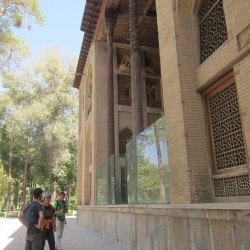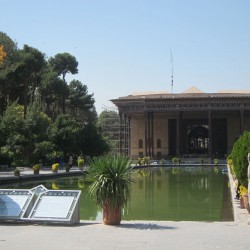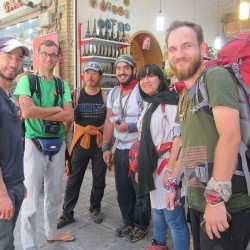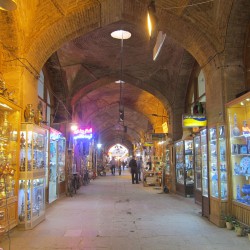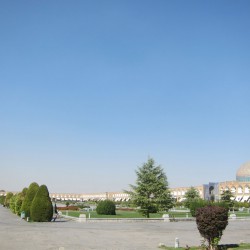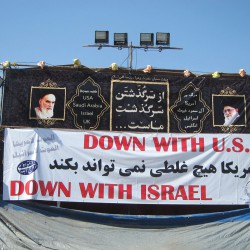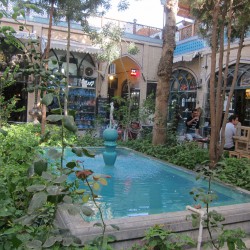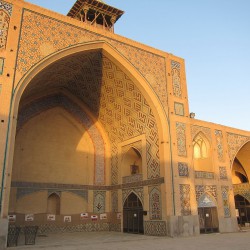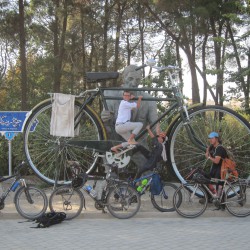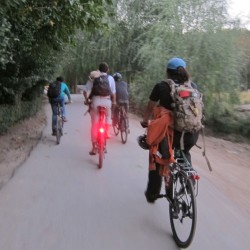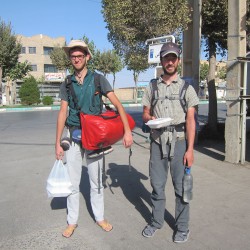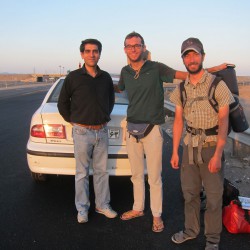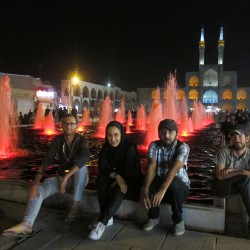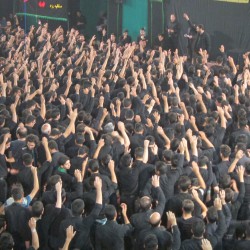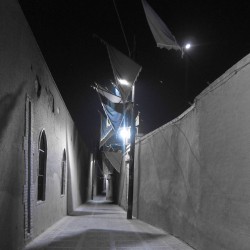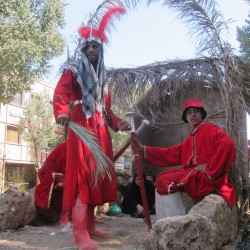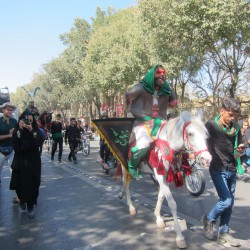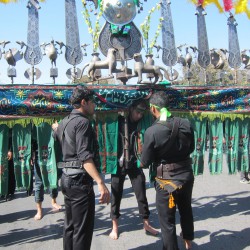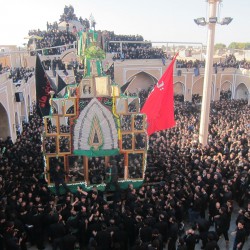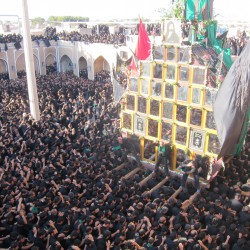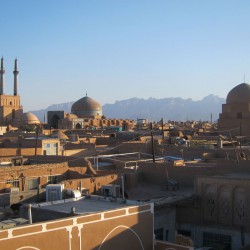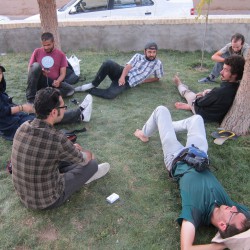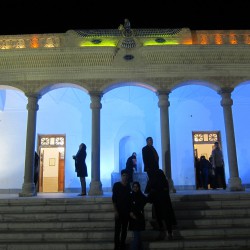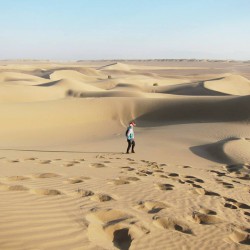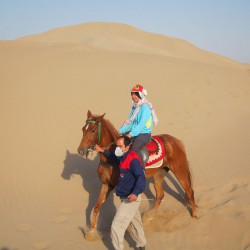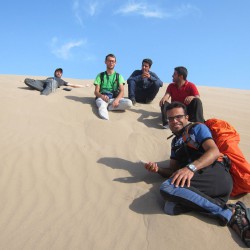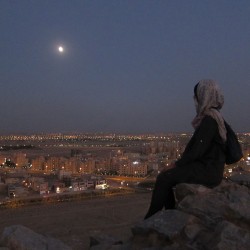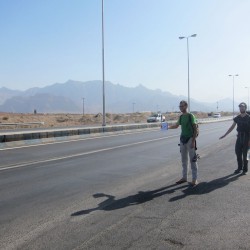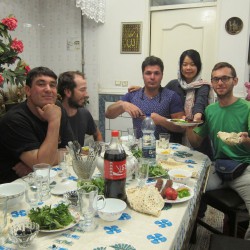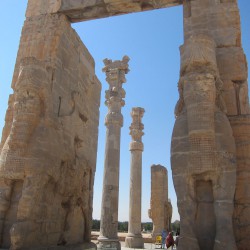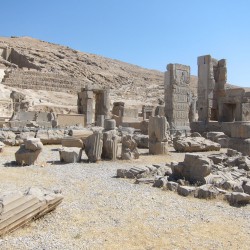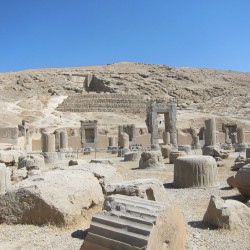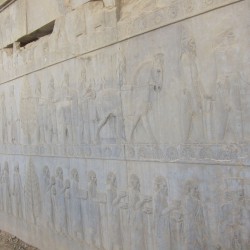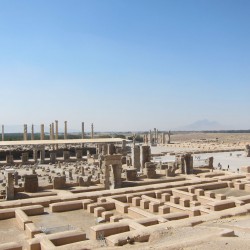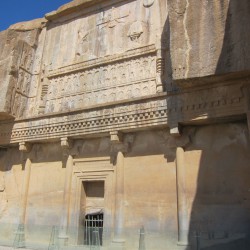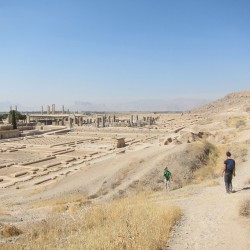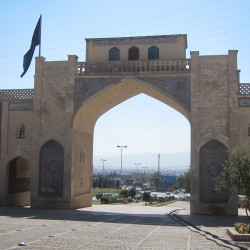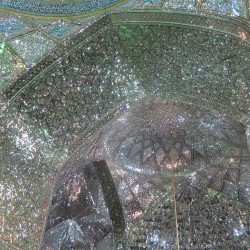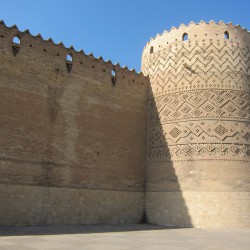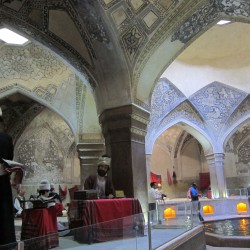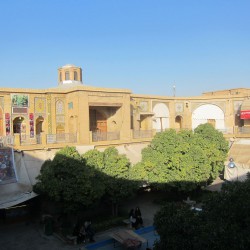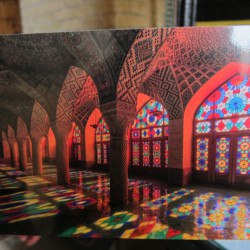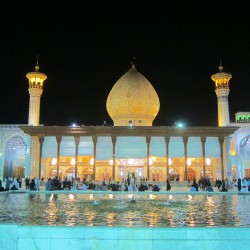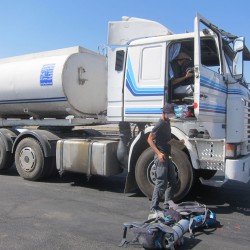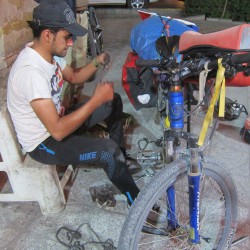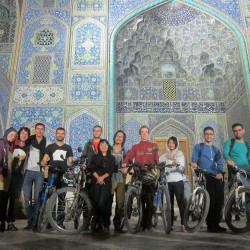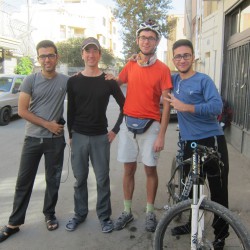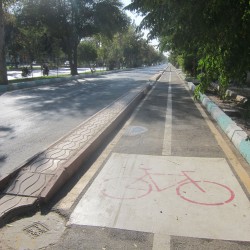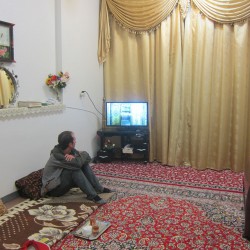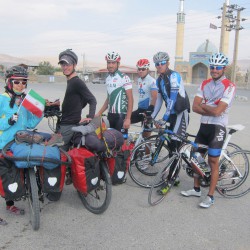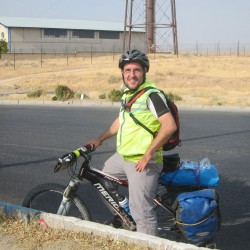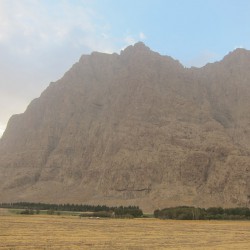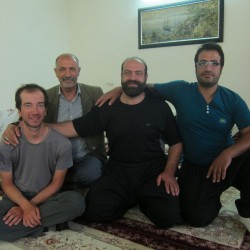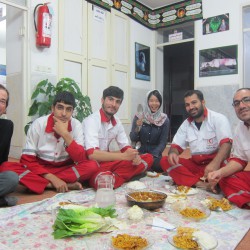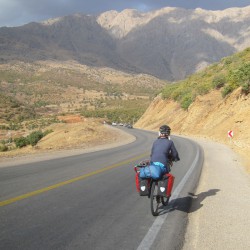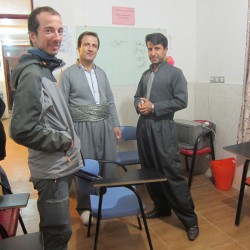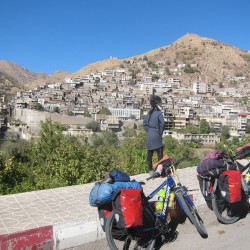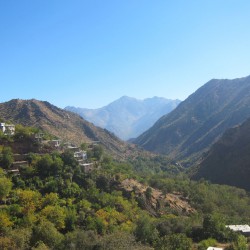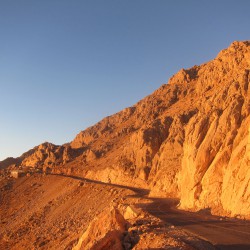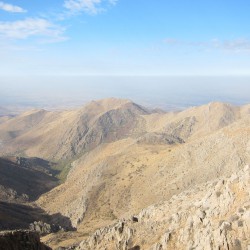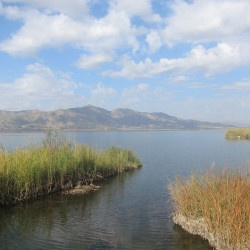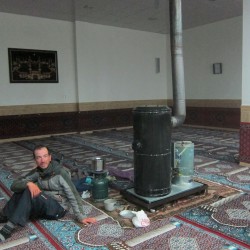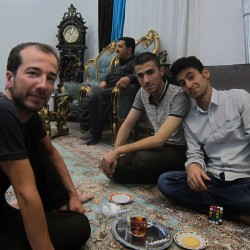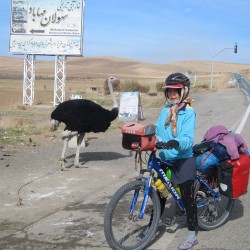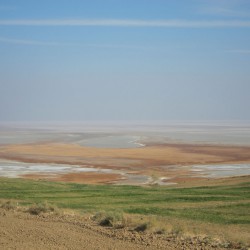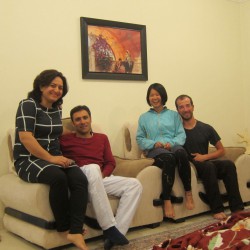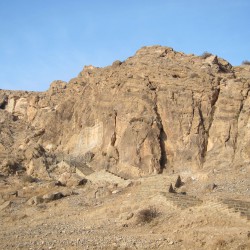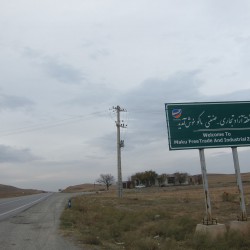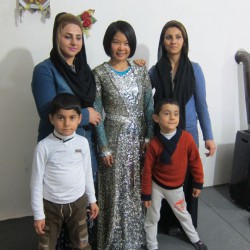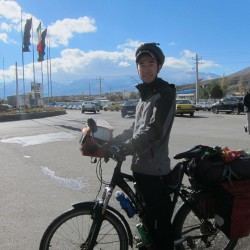After cycling through northern Iran, we were now in full tourist mode, visiting historic cities and sights. One of the most regarded places in this regard was Isfahan, and we were excited for it!
Pictures by Yuily, text by Stephan.
Isfahan
We had planned at least two days of sightseeing as Isfahan was full of attractions. For Pierre, he also had to extend his visa, but decided to do so on the next day so he could enjoy the sights with us. Additionally, Harry, the Taiwanese cyclist we met back in Darkesh, was also in the city, staying in a hostel. We met up as a cyclist foursome to do some sightseeing.
Most of the attractions unfortunately had a steep entrance fee of IRR200k, so it was disappointing to skip so many things and just see them from the outside. Luckily, the big Imam Square, on the world heritage list, was free and quite nice to hang out in.
- Old palaces…
- … of Persian kings.
- Iranian backpackers
- The tourist bazaar
- Imam square – world heritage
- Propaganda
- Plenty of chillout spots
- Impressive mosques everywhere
Interestingly, around here we met speakers of each of our languages: French, German and Mandarin. Together with by far the most foreign tourists we’ve seen yet, it was clear to see that Isfahan is Iran’s most touristy city.
Our warmshowers host Reza was fantastic. He and his family took great care of us, but also gave us plenty of personal space. He took us on a great ride through fantastic cycle paths and country lanes on one day.
- Four silly tourists
- The Armenian church
- Very good cycling paths
The day came to see other cities of Iran. Yazd and Shiraz were absolute must-see’s, but unfortunately too far east and south to visit them by bicycle. So we planned to leave the bikes in Isfahan and hitchhike in a triangle to these cities and back. Reza gladly agreed to store the bicycles for us.
Yazd
Reza kindly drove us to the bus stop, from where we got a local bus to the outskirts of Isfahan. From here, we still had to walk 3 kilometers to the expressway entrance. On the way, several locals tried to hand us takeaway boxes of food, and with the insisting nature of Iranians, we soon had three packets of food in our hands. We soon learned what that was about: During the Ashura public holidays, free food is handed out at certain locations.
Ashura was a public mourning for the grandson of Mohammed, Hussein. Back then, he criticized the caliph for his indulgence in sins, for which the caliph murdered him and his family. This event effectively split the Sunni (who follow the caliphs) and Shia Muslims (who follow the Imams, like Hussein), to this day. Many of the conflicts in the Muslim world today (such as in Yemen) are actually Sunni-Shia conflicts.
Reza really recommended us to reach Yazd in time for Ashura, as that city is known to have some of the most impressive parades.
Hitchhiking worked well and on our last ride towards Yazd Payman and Hussein, two Tehranis on their way to there, themselves couchsurfers and hitchhikers, speaking perfect English, picked us up. We reached the city quickly and in good company.
- Free food!
- Hitchhiking works
- Made it with new friends
Events for Ashura were already underway as they invited us to come along. They met up with two other friends and so our group of seven now went to a hall to see a public moruning. As we tried to enter looking like obvious tourists, we got intercepted and given premium seats on the upper ranks. Due to the excellent English of our new friends, they got mistaken for foreigners and went in with us as well.
It was quite an impressive scene. People dressed in black were all chanting in chorus and beating their chest with their hands, which made a shattering noise through the hall. After around 15 minutes all the people left and a new group came in, repeating the same thing.
We went through the old town in search of Nasri, the free food that is handed out. Sure enough, we quickly found a place and were given seats at a quieter location again due to our status as foreigners. Wandering the old town at night was quite amazing already. The winding streets of the mud-brick architecture are something that is really worth seeing.
Later, our new friends arranged for us to come along to their hosts place and camp there. Great company, great new friends.
- Chanting and chest-beating
- The highest mosque of Iran
- Mud-brick old town
- Free food!
The next day was the main Ashura day. Naturally, a big parade went through the city which we went to watch. It was impressive, with many people lugging objects around which weigh 200 kg and numerous displays of prophets and Hussein’s rebellion force. Free tea was handed out everywhere from stands blaring out chanting music. After more Nasri food and sightseeing in the old town, we found ourselves in a park relaxing and watching the same event as the previous day.
The time came for our new friends to leave. They were perfect company for two days and we really enjoyed being around with them. That also meant we had to find a new host: Mohammed, a busy businessman but kind warmshowers host, let us crash in his office.
- Paraders
- Brutal
- Lugging heavy things
- Ancient air-conditioning
- Lift and …
- … go round and round
- Yazd old town
- Being lazy
Me and Yuily extended our visas a second time. The process was a little easier this time with a friend of our host knowing a local contact, but still a bureaucratic mess of paying here, get photos there, come back, fill form, etc. that took most of the day. We got 30 extra days and, knowing that this was the last visa hassle for a long time, were relieved.
Mohammed was another excellent host, and although he was busy most of the time, his English students and friends hung out with us and one offered to take us to a sandy part of the Kavir desert. One of Yuily’s big dreams. It ended up being a really spectacular experience.
Later, we also got to meet Mohammed’s four year old daughter, Anita. We were all super impressed by her intelligence: She spoke perfect English, was able to cook, calculate and write. I’m absolutely sure she will be a president someday. Unfortunately, Iran doesn’t treat women very nice overall, confining them to traditional dress codes and gender rules by law…
- Zoroastrian temple
- Awesome desert
- Yuily horseriding
- Being lazy
- Zoroastrian burial place
- Mohammed and family
Persepolis and Shiraz
It was time to contact our friends from Shiraz again that we met on the first week of cycling, because now we were going there. It turned out that they live in Marvdasht, the closest city to the ancient ruins of Persepolis, 50 km from Shiraz. Perfect, because Persepolis was our main focus.
We hitchhiked there and had the small issue that a driver expected money, even though we said we were looking for a free ride. I think we were not clear enough in the beginning. But we bargained his ridiculous demands of IRR3.000.000 (EUR80) down to something reasonable.
Our friend Hamid was every bit as crazy as I remembered, making me and Pierre dance and shout random Persian greetings into his phone and driving fast with loud music. Yuily was greatly entertained, as thanks to the Iranian gender separation customs, Hamid never demanded her to play along, so she could just watch in amusement. It drained my energy really quickly though. Hamid’s family was absolutely fantastic, treating us some of the best home cooked meals we ever tasted.
- Shiraz, please
- An impressive small town on the way
- Hamid’s family and awesome food.
Persepolis itself was very close by. These ancient ruins mark the first Persian capital, 2500 years ago. It barely held a few hundred until it got burned to a crisp by Alexander the Great. Still, it was monumental and awe-inspiring. The area was huge with many things to explore, and the whole time I felt like an explorer. I’ll let the pictures speak for themselves.
We took another day to explore Shiraz, just a 1 hour bus ride away. People from all over Iran have told us how this is the most liberal city of Iran, but we didn’t see any evidence of that. To me, it essentially like a smaller version of Isfahan. Most of the attractions, as usual, cost IRR200.000 to enter, out of our budget. The Nasir Al-Muq mosque, famous for the colorful light in the interior, was apparently only worth it in early morning, so we skipped it too.
- The old city gate
- Inside a holy shrine
- The citadel
- Inside the bazaar
- Similar to Isfahan
- Pretending, photographing a postcard
- The main holy shirne…
- … of Imam Reza’s brother
Hamid and his family were really really awesome hosts, but it was time to return to our bicycles in Isfahan. We tried from a bus stop on the highway, where multiple people tried to discourage us, saying it would be impossible to get a free ride. We walked past their dropped jaws then when 10 minutes later a truck picked us up towards Isfahan.
We returned to Reza’s place and got our bicycles serviced at a bike shop. So far, we traveled as a threesome with Pierre since we met him in Qom, but the time came to say goodbye. We eventually had the same destination, the Turkish border, but he wanted to get there as quickly as possible, since he got a job offer in Europe. Our route was a bit longer and would take us close to the Iraq border into Kurdish areas of Iran. So, this was goodbye for now – Pierre had been an awesome companion and we hope to meet him again!
- Our ride
- Servicing the bikes
- Bike tourers and backpackers
- Saying goodbye to our hosts and Pierre
Skimming the Zagros
We had over 1500 km to go and a little less than one month to do it. It turned out to be a very good pace: Not too rushed, allowing for a few rest days, but not too relaxed either, keeping us moving. What also helped is that since returning to Isfahan, we definitely noticed that autumn has arrived: The temperature was a tolerable, nice 25°C during the day, while at night it got straight up cold. For cycling, this works out perfectly.
From Isfahan, we followed the ridges of the Zargos mountains, which mark the western edge of the plateau Iran sits on, towards Kermanshah. It’s more like an uneven plateau, as some valleys even sit at 2500 m. This gave us some nights with temperatures dipping below freezing during the night, but we never really had to worry too much about cold camping.
Now that we left the tourist trail of Iran, people in the villages on our way were very hospitable. A question of where we can camp was very quickly followed by an invitation to someone’s home, where we would be treated like royalty. On one occasion, we were led to a private room with TV, got brought food on a regular basis and our bedding for the night without question in a very polite manner. I really had to ask if we got led to a hotel by accident, but no, it was just incredible generosity.
- Bicycle lane out of Isfahan
- Our own room with heater and TV
- Along the Zagros
- Local cycling club
- Cyclist encounter: Spain
- Ancient Bisotun is there
- Our first Kurdish host
- Hosted by Red Crescent
It took us a week to reach Kermanshah along busy highways, by which we were a bit drained by the constant hospitality so we actually chose to camp. It took a really hard time to convince people that came by that we are fine and not too cold, respectfully declining their offer to come to their home. From here, we would follow a quieter mountain road that we were looking forward to.
Exceptional Kurds
Kermanshah and many areas in western Iran are ethnically Kurdish. Kurds are one of the largest ethnic groups in the world without a nation, being spread across Turkey, Iran, Iraq and Syria. They are related to Persians, with their languages having some similarities, but are mostly separate due to being mostly Sunni Muslim. Throughout Iran they are known for their exceptional hospitality, even exceeding the rest of Iran. What were we in for, and how possibly could we receive even more generosity?
We started climbing into the mountain areas and chose to sleep in a mosque. There, an English teacher, who was also active on couchsurfing, found us and invited us to his home in Paveh for the next night. We had a wonderful time, chatting away with his students, friends and family. One of his students helped me to get new pants and a haircut, for which the hairdresser viciously refused my payment.
Dropping into a steep mountain valley, we wanted to shelter from oncoming rain. A farmer who invited us in told us (in sign language) “I have to leave for the night, here’s the key, lock when you leave and make sure to turn the lights off. Be comfortable, bye.” He just entrusted some strangers with his house! The next morning, his wife entered the house, surprised to find us, but instantly embracing us, telling us to relax.
In Marivan, a middle-aged woman started talking to Yuily out of curiosity. It didn’t even take one minute for her to invite us to stay at her house tonight, which was really big and luxurious. We had a very comfortable night. And whenever we were not invited to someones home, the village mosque pretty much always was available for us to crash in. We only camped one night.
- Suddendly, beautiful scenery
- English teachers as hosts
- Nowdeshah
- Beautiful valleys, tough climbing
- Worth it
- Good morning Iraq
- Lake Zeribar, close to Marivan
- Sleeping in a mosque
It was incredible, these people just had absolutely no hesitation to invite strangers. It absolutely spoiled us for other countries that we would visit and sadly we knew already that we cannot expect this kindness and hospitality somewhere else. Of course, this also led to some strange situations: A man stopped his car and asked us if we had a map. He found his city and said he would invite us tonight there. Unfortunately, it was 50 km off our route, so I declined. He insisted, saying he wants to show me hospitality, and suggested to pick us up by car at the junction. And what about the bicycles? I still declined with a more loud and clear “NO”. He went back to his car with a sad face. Sometimes people want to help so much that they don’t realize their actions cause me more inconvenience than actual help.
The road was incredibly tough, dropping from 1800 to 500 m, only to rise to 2500 m within just 20 km again. But it was also incredibly beautiful. So far, Iran was not exactly a beautiful country concerning nature: Most of the interior is brown hills and the forests and beaches on the Caspian coast are nothing special either. But here, we found a true gem. The valleys we crossed were spectacular and the high mountain ridge we followed from Paveh to Marivan gave us great views into neighboring Iraq. This was by far the most scenic part of Iran we visited.
Racing to Turkey
After a well-earned rest in the city of Saqqez, the first we had since leaving Isfahan, we were slowly leaving the mountains towards the flat plain surrounding Lake Urmia. So far, we definitely felt the nights becoming colder. Winter was coming and we were going north: Double effect. Most nights hovered around freezing now and made camping less comfortable. We also didn’t have many days left on our visa, so keeping moving fast was essential.
Due to the cold nights, we now jumped at every opportunity to sleep inside. In the city of Urmia, I got a positive reply from a couchsurfing host while we were already lying in our sleeping bags in the tent. Under normal circumstances I would’ve declined the offer, but the cold night motivated me to get out again and pack the tent to move to our hosts place. In a village close to the border, I contacted a warmshowers host last-minute, making him come from a city 100 km away to host us at his parent’s house. In retrospect, I shouldn’t have bothered him so much. But this is Iran: Once someone made up his mind to host you, it will be impossible to say “Don’t worry, we’ll just camp, it’s fine”.
The relatively flat terrain had us arrive a day early, so we planned to sleep a final night in the border town, Bazargan. By now, night temperatures were a solid -5°C, so the drive not to camp was even stronger. But we didn’t pay for any accommodation in Iran for 91 nights so far, and we didn’t want to mess up that record. It might sound silly, but we were ambitious in that regard. Fortunately, some curious people handed us a phone, with the English-speaker on the other hand saying “No problem, come to my house”. His name was Amin, a wonderful coincidence as our first host back in Mashhad shared the same name, and he treated in a great way. The next morning, he made sure we crossed the border without problems as he worked there.
- Hosts in Saqqez
- Don’t you belong to Africa?
- Lake Urmia
- Our hosts in Urmia
- An ancient carving
- Closing in on the border
- Kurdish clothes
- Border!
Final Impressions on Iran
All this hospitality in Iran was what made the country so memorable for me. I heard about all of this before, but nothing could actually prepare me for what I experienced here. I believe the two articles already give a good enough impression about all the positives of the people. It did get annoying a few times, as quite often when we were invited we didn’t really get to rest, as we were constantly asked questions and offered to be shown around. This made me deliberately decline invites and camp instead on a few occasions so I could have my peace at the end of a day.
Iran’s society and government is highly religious, most famously with the hijab requirement for any women. But it has much more idiocy than that: Women cannot dance or sing, in some provinces it has even been declared illegal for them to ride bicycles. Religious police has become much less oppressive in the last few years, but they still exist. Alcohol and pork are of course absolutely illegal. I craved for a beer so much at the end of those three months. The government and laws, make no mistake, are some of the most oppressive in the world. Many many Iranians we met (but by far not all) loathe their government for these reasons and their primary goal in life is to leave the country to live elsewhere. Germany is very, very popular as a destination for many, so I got lots and lots of questions like “Stephan, how can I move to your country? Can you help me?”
Iranian traffic was one of the lows. Although the driving standard was bad, it was a little better than in Central Asia. The sheer volume of traffic was absurdly high on just about any road. Most roads had a hard shoulder, but the few that didn’t caused a few hair-raising encounters. All of the roads were of good quality though and I could safely choose side roads counting on them to be paved. Only once a side road ended up at a river crossing. Honking was another problem. Not as much as in China, where it’s mostly the “Watch out, I’m coming” type of honk. Most people just honk to say hello, repeatedly. The intend may be nice, but it’s incredibly annoying.
Overall, I can still highly recommend this country for a cycling trip. It’s the way to really get to know the country and the people, and due to the easyness of camping and prevalence of warmshowers, it’s pretty great for cycle touring, especially if you can find one of the few routes that has less traffic.
Blue = Cycling, Brown = Hitchhiking
Previous: Iran Part 1
